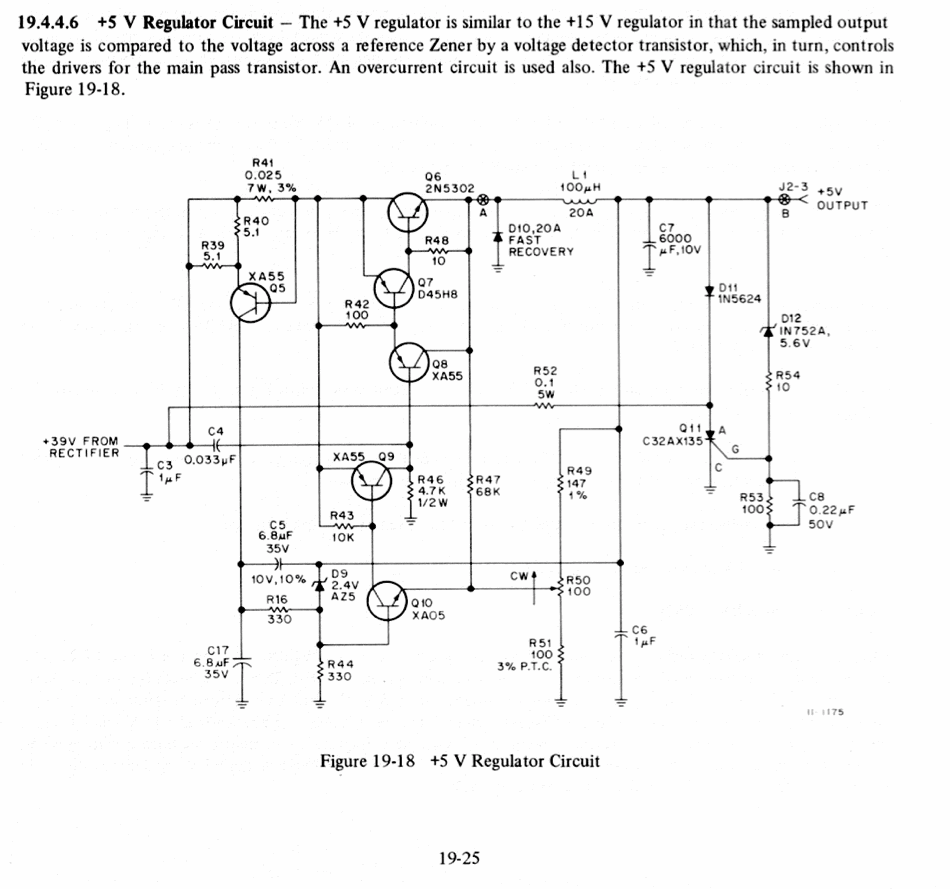You’re probably wondering to yourself, “Self, why hasn’t Twylo updated his PDP-11 repair journal lately? It’s been days!”
I can sum it up with one schematic:

That’s the schematic for the +5V regulator in the 11/35’s power supply. It blew up on me (figuratively) just as things were getting good.
It all started on Sunday morning. I wrote up an in-depth testing plan to let me debug the flakey CPU logic step by step, tracing signals from the console into the CPU and examining the behavior at each step. Of course, the first step was to verify that +5V was making it to Vcc on the ICs. I had fully tested the power supply a few weeks ago before putting it back into the chassis, and an IC not getting power would be a pretty obvious problem, so I didn’t expect to find any issues.
Well, I was in for a surprise. I was reading a mere +4.4V on Vcc. I checked several ICs on multiple cards, and they were all the same. +4.4V is way below the recommended tolerance for the first-generation TTL logic used in the KD11A CPU! That alone would probably cause things not to run. So I felt like I was definitely onto something here. The H750 power supply has little potentiometers to adjust the voltages on the output of each regulator, and I’d adjusted the 5V output to pretty much exactly 5.00V. But I did so without any load on the supply, and I think that was my problem. I decided to re-adjust the voltage with the system loaded and get it back up to +5V. Lo and behold, as I was adjusting the voltage, the LEDs started to flicker, as if a bit of life was coming back into the CPU. It looked almost like it was trying to run!
And that’s when things went wrong.
Suddenly, there was the tiniest popping sound from the power supply, and all the LEDs went out. I instantly shut off the power, but I knew full well it was a fuse. The regulator has an overvoltage protection circuit built into it, right at the end. This is commonly called a “crowbar circuit” (I guess because it’s like taking a crowbar to something to shut it off). It’s composed of D11, D12, and Q11 in the schematic above. It’s very simple: if the output voltage of the regulator goes above the breakdown voltage of zener D12 (5.6V), D12 starts to conduct in the reverse direction, and suddenly there’s a voltage across R53. This voltage is sensed by Q11 on its gate input, causing current to flow from the anode to the cathode. Q11 can sinks a lot of current, and when it’s sinking about 16A, fuse F1 (not pictured) pops and shuts the whole circuit down. Since the SCR and D11 are both rated for 20-25A continuous, in theory everything should be happy once you turn the voltage potentiometer back down and replace the fuse.
In my case, though, that’s not what happened. I replaced the fuse, turned the voltage down, and powered the PSU back up. POP! The fuse blew again. Bad sign.
So I started more troubleshooting. I had some false starts and drew some incorrect conclusions, but before the end of the night I’d discovered that D11 was dead shorted. In fact, its package had cracked! So any time I applied power after that, +39V would go to the +5V output and the fuse would blow again right away.
Sigh. Nothing else for it, I wrote up an order to Mouser and Jameco and ordered some replacement parts. Since I’ve had trouble with this supply before, I added some extras stuff onto the order. In addition to the 1N5624 that shorted, I bought replacements for several core parts that may fail in the future, including power transistors, A05 and A55 transistors, zener diodes, etc., just in case! Total cost was less than $30, so I consider it an acceptable investment.
The parts should be here by Thursday, and then I will be back to my regularly scheduled debugging. Until then, I must twiddle my thumbs.
Comments